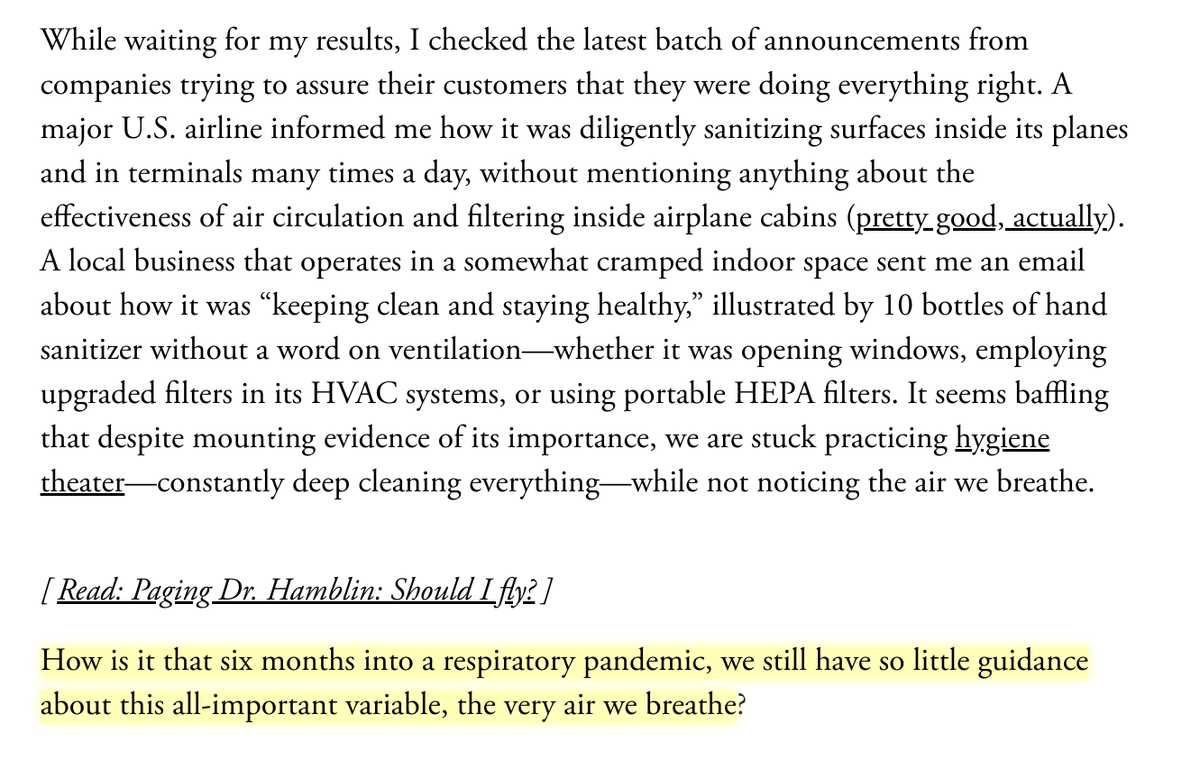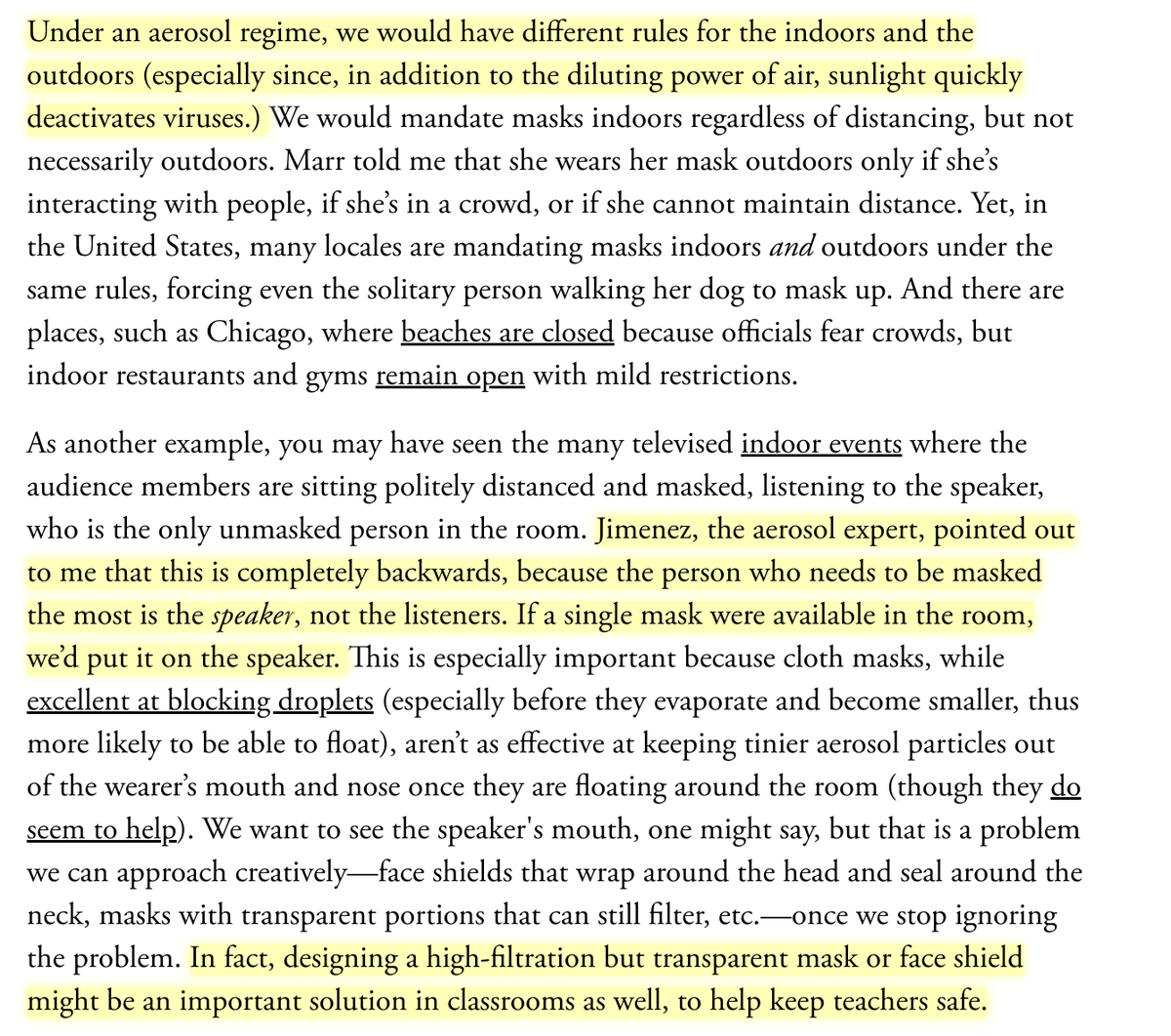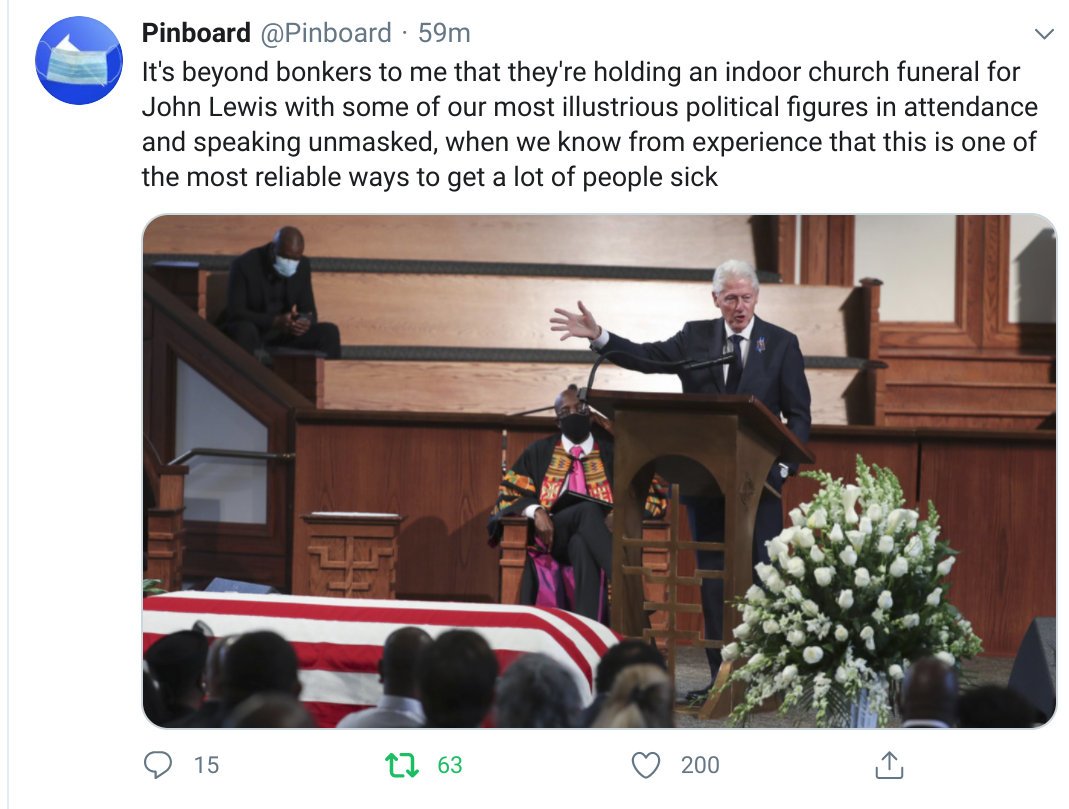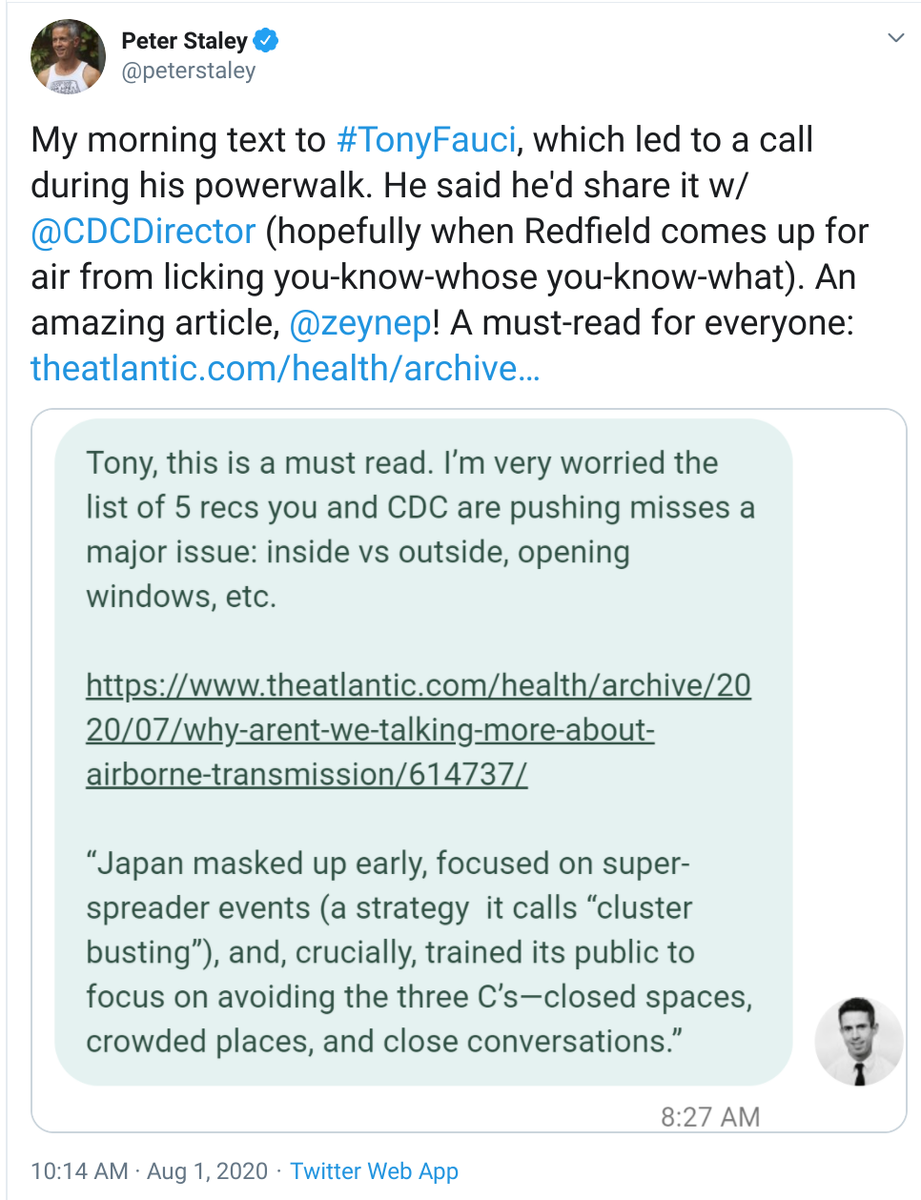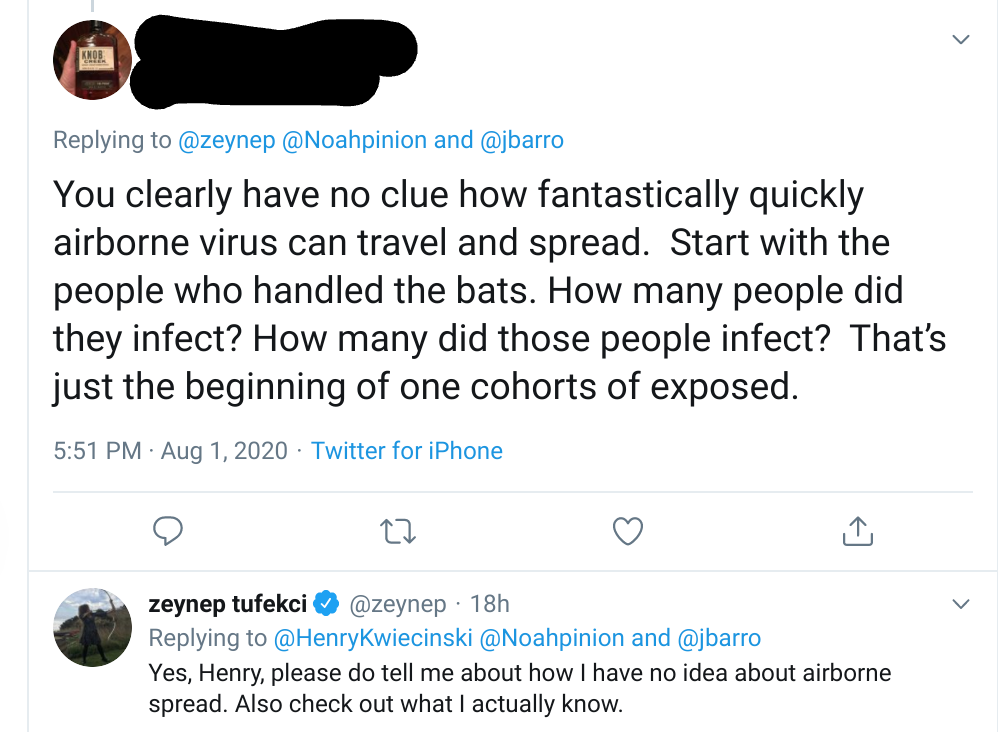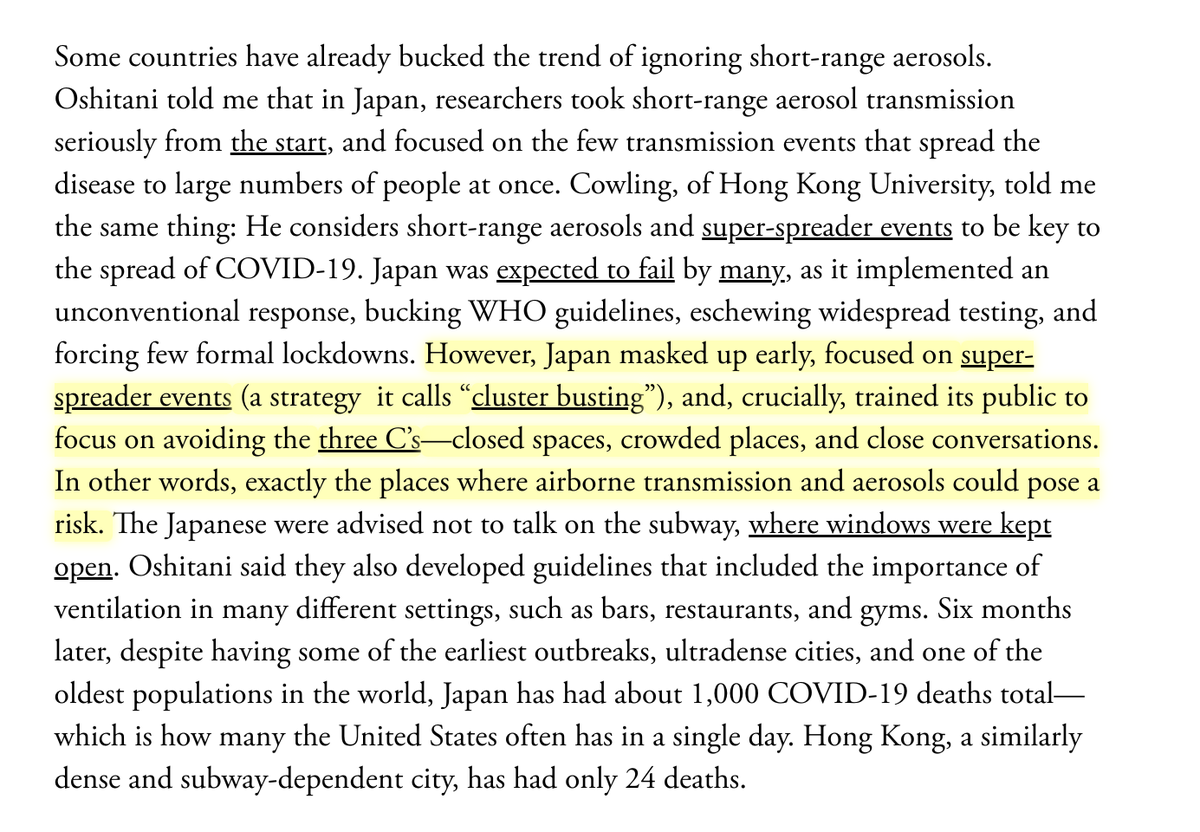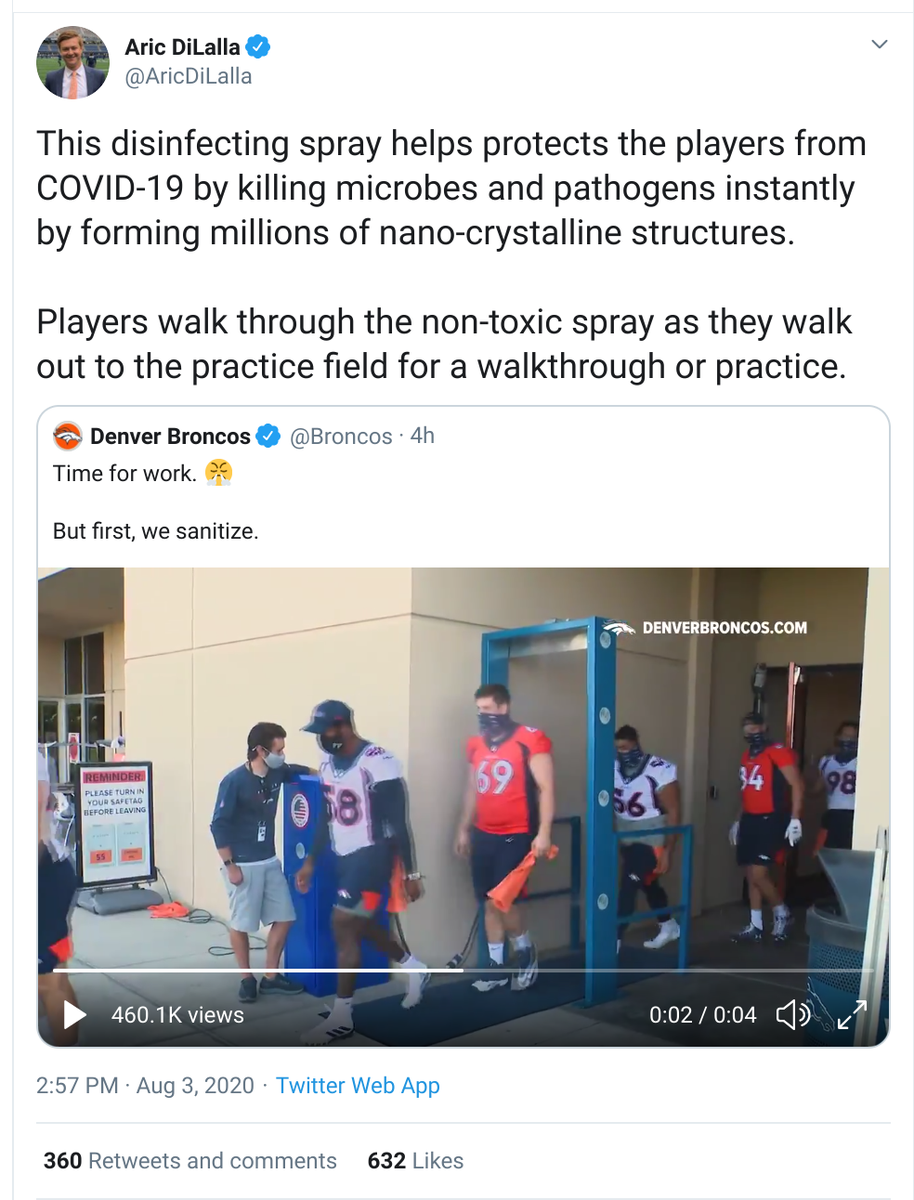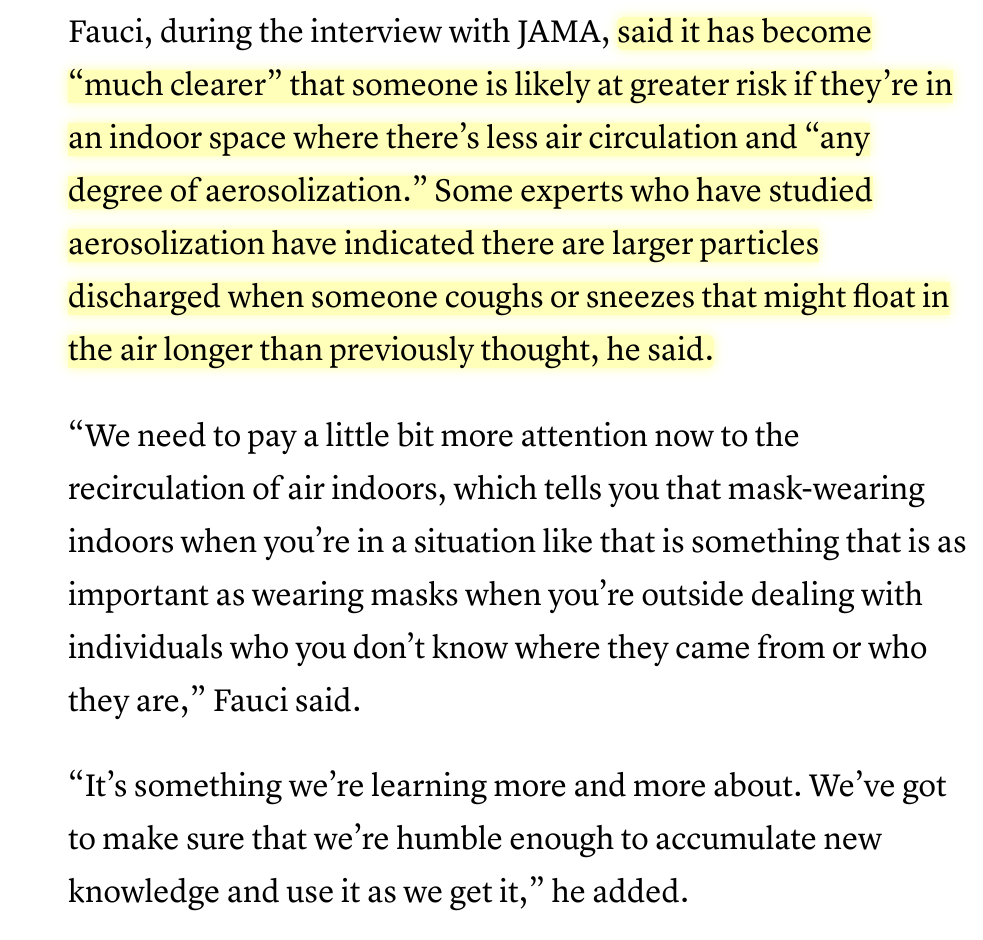We urgently need to focus on ventilation. Six months into a respiratory pandemic, we're still not given sensible and practical guidance against short-range aerosol—airborne—transmission of COVID. I wrote about the science & what it means we should do now. https://www.theatlantic.com/health/archive/2020/07/why-arent-we-talking-more-about-airborne-transmission/614737/
There's strong accumulating evidence that, under the right conditions, COVID can be transmitted in ways that are not currently reflected in our guidelines. People urgently need to understand what's happening and why so they can take the correct steps to mitigate. Crucial for all.
Some steps to mitigate short-range aerosol transmission are cheap, even free. Some are expensive and require needed upgrades to our infrastructure. There is also a lot of unnecessary fear and scaremongering! Don't fall for it. Read, be informed, mitigate: https://www.theatlantic.com/health/archive/2020/07/why-arent-we-talking-more-about-airborne-transmission/614737/
Much gratitude to many scientists working so hard practically around the clock with the research but who took time to talk with me. I tried to do my best to take some of the load, by writing a piece that communicated their shared findings—whatever the remaining open questions.
Ventilation in July is like masks in March. There's accumulating evidence AND many practical steps to take. Some are within our reach for free or cheap, and we should prioritize the expensive ones. Instead, we're stuck, without guidance. Let's change this. https://www.theatlantic.com/health/archive/2020/07/why-arent-we-talking-more-about-airborne-transmission/614737/
Deep gratidude to @angie_rasmussen @linseymarr @SaskiaPopescu @Don_Milton @Ryan_Mac_Phd @jljcolorado @bencowling88 & Dr. Hitoshi Oshitani. They work so hard to communicate the science with the public & it's been an honor to try to put it all together.  https://www.theatlantic.com/health/archive/2020/07/why-arent-we-talking-more-about-airborne-transmission/614737/
https://www.theatlantic.com/health/archive/2020/07/why-arent-we-talking-more-about-airborne-transmission/614737/
 https://www.theatlantic.com/health/archive/2020/07/why-arent-we-talking-more-about-airborne-transmission/614737/
https://www.theatlantic.com/health/archive/2020/07/why-arent-we-talking-more-about-airborne-transmission/614737/
Correctly understanding the specifics of airborne transmission of COVID is *really important* because it changes many things about our guidance on masks and distancing like who should mask? When? How? When is six feet not enough? Should we mask outdoors? https://www.theatlantic.com/health/archive/2020/07/why-arent-we-talking-more-about-airborne-transmission/614737/
Yes. Taking short-range aerosols plus superspreading seriously has implications for almost every aspect fighting COVID. Japan, which long took airborne transmission seriously, does contact-tracing differently (cluster-busting) exactly for this reason. https://twitter.com/bendadams/status/1288858770983006208
There is urgent need for practical guidance for schools and other indoor spaces. For now, see thread from an excellent scientist. Lack of official guidance means there is a lot of snake oil in this space. Basic HEPA filters work, though. See for details-> https://twitter.com/CorsIAQ/status/1288739096148336642
Another expert with specific guidelines. https://twitter.com/ShellyMBoulder/status/1288327833799008257
Yes, there is an excellent detailed spreadsheet with different places/scenarios (class/subway/campus) by @jljcolorado that the more engineering-oriented can play with. Make a copy, fill in orange boxes to get estimates: https://docs.google.com/spreadsheets/d/16K1OQkLD4BjgBdO8ePj6ytf-RpPMlJ6aXFg3PrIQBbQ/edit#gid=154529406&range=A159 https://twitter.com/DrZackaryBerger/status/1288891458783715330
One implication: We should have found a way to honor John Lewis without endangering the many vulnerable people in that room. Hopefully they have high CADR HEPA filters or someone checked the ventilation specs. It's the speaker that's emitting the aerosols. https://twitter.com/Pinboard/status/1288881445876822017
Let me say this outright: This is unscientific, stupid and wrong. This is incredible. Six months in, how can we be this behind the science? This make so little sense that my head hurts. This is why focusing on the right science matters. h/t @MartynaAFox https://twitter.com/POLITICOEurope/status/1288897647344889863
So, this is ridiculous. @Delta is trying to reassure me flying is safe by mentioning... Lysol! Disinfecting! But not mentioning the actually reassuring things: cabin air is recycled every few minutes; cleaned by HEPA filters that can remove viruses and is circulated vertically.
Yes very much. I’ve been corresponding with Japanese experts and I have their documents going back to March. They’ve really been on the money. My piece has more on what Japan figure out to do because they took short-range aerosols seriously from the start. https://twitter.com/covidpath/status/1288863784358916097
Thank you! Indeed, ventilation is a layer in the mitigation stack. But understanding the role of short-range aerosols and potential airborne transmission makes how we should do the rest clearer. https://twitter.com/brianbruce7/status/1289039672627396608?s=21 https://twitter.com/brianbruce7/status/1289039672627396608
Note to editors assigning COVID pieces. This is ~5K words, (Had another 1K on hygiene theater when @DKThomp scooped me with a great piece!). Overwhelming feedback: thank you for the details! Do let your writers go long and treat the reader as a partner. https://www.theatlantic.com/health/archive/2020/07/why-arent-we-talking-more-about-airborne-transmission/614737/
https://www.theatlantic.com/health/archive/2020/07/why-arent-we-talking-more-about-airborne-transmission/614737/
 https://www.theatlantic.com/health/archive/2020/07/why-arent-we-talking-more-about-airborne-transmission/614737/
https://www.theatlantic.com/health/archive/2020/07/why-arent-we-talking-more-about-airborne-transmission/614737/
Yes. When schools open, they need to focus on ventilation, masks and distancing/separation especially among the staff and the older students. A sensible level of cleaning high-touch surfaces is good, but ventilation/masks is key and not to be overlooked! https://twitter.com/rachbarnhart/status/1289245963773546500
People have been asking about germicidal UV lights for killing the virus in indoor spaces. It is a real tool, and hospitals use it, but I did not include that in the article because it is not something to try without calling in the experts. Real dangers. https://www.theatlantic.com/health/archive/2020/07/why-arent-we-talking-more-about-airborne-transmission/614737/
I’ve been looking for a good analogy to airborne vs sprayborne, and asked all the experts, and this may yet be the best (for people who go to hair salons!)  This matters, because having the correct mental model can empower people to think through this. https://twitter.com/tressiemcphd/status/1289602987711582208
This matters, because having the correct mental model can empower people to think through this. https://twitter.com/tressiemcphd/status/1289602987711582208
 This matters, because having the correct mental model can empower people to think through this. https://twitter.com/tressiemcphd/status/1289602987711582208
This matters, because having the correct mental model can empower people to think through this. https://twitter.com/tressiemcphd/status/1289602987711582208
Exactly. Aerosols are like short-range mist—the closer you are to the person emitting it, the more exposure *but* under the right conditions (poorly ventilated indoors space), the mist can accumulate and even be pushed around by air currents beyond 6 feet. https://twitter.com/dylanhmorris/status/1289612851762667521
What it's like to be a woman writing about tech/science/society. Two things happened the same day, and one of them is random dude telling me I "clearly have no clue" about airborne spread, just after I wrote a ~5K article about it. No track record is ever good enough for women.

Because of my piece on ventilation, I keep getting asked for practical advice. CDC and health authorities should update guidelines. But for individuals? I'd say avoid Japan's 3Cs: closed spaces, crowded places, close-range conversations. And wear masks. https://www.theatlantic.com/health/archive/2020/07/why-arent-we-talking-more-about-airborne-transmission/614737/
Pandemic theater. Broncos players are coming out of an *indoors* locker room, to pant at each other at close range, but not before being sprayed by, uh, mumbo-jumbo nano-crystalline disinfectants!. (Do more! Activate the holosensors! Use positronic beams too!)  ht @benjiwade
ht @benjiwade
 ht @benjiwade
ht @benjiwade
I mean if we’re going to do pandemic theater, at least let’s do it right, with some elegance amd history. My grandmother would’ve put an evil eye charm on all of them.  Tradition > technobabble.
Tradition > technobabble.
 Tradition > technobabble.
Tradition > technobabble.
Write an article about aerosols, get a LinkedIn inbox that feels like who's who of HVAC/IAQ companies. No I can't endorse products.
No I can't endorse products.
 But my own AC is on the fritz? (And my landlord is trying to evict me, so not going corrupt and helping fix his AC for free at the same time!)
But my own AC is on the fritz? (And my landlord is trying to evict me, so not going corrupt and helping fix his AC for free at the same time!)
 No I can't endorse products.
No I can't endorse products.
 But my own AC is on the fritz? (And my landlord is trying to evict me, so not going corrupt and helping fix his AC for free at the same time!)
But my own AC is on the fritz? (And my landlord is trying to evict me, so not going corrupt and helping fix his AC for free at the same time!)
YES! Dr. Fauci acknowledges some aerosolization. Says indoor/outdoor different, indoors "much greater risk than outside.” Emphasizes "mask-wearing indoors." Acknowledges ~5-10 μm can float, says they likely got that wrong. Now, hopefully new guidelines! https://www.cnbc.com/2020/08/03/fauci-says-theres-a-degree-the-coronavirus-is-spreading-through-air-particles.html
Now, hopefully new guidelines! https://www.cnbc.com/2020/08/03/fauci-says-theres-a-degree-the-coronavirus-is-spreading-through-air-particles.html
 Now, hopefully new guidelines! https://www.cnbc.com/2020/08/03/fauci-says-theres-a-degree-the-coronavirus-is-spreading-through-air-particles.html
Now, hopefully new guidelines! https://www.cnbc.com/2020/08/03/fauci-says-theres-a-degree-the-coronavirus-is-spreading-through-air-particles.html

 Thrilled to see the message about the importance of ventilation *finally* breaking through to the broader public (at least, I hope so!). (Sane policies for/media coverage of the safer activities outdoors, maybe, too, one can hope?) https://twitter.com/misguidedsoul7/status/1291069337600774144
Thrilled to see the message about the importance of ventilation *finally* breaking through to the broader public (at least, I hope so!). (Sane policies for/media coverage of the safer activities outdoors, maybe, too, one can hope?) https://twitter.com/misguidedsoul7/status/1291069337600774144
Why important to understand the role aerosols may play correctly even though they, too, cluster in close-range of the person. Droplets=only in front of one. Aerosols=escape behind one if mask is poorly fitting. Keep your mask on indoors even at distance. https://twitter.com/jljcolorado/status/1280935408398766080
Short answer: Hepa filters with no gimmicks (ionizer, UV) are good for unventilated spaces. Higher CADR (smoke rating) is better. If you can open windows/doors for good air circulation, better. Better answer: follow @jljcolorado @ShellyMBoulder @kprather88 https://twitter.com/__apf__/status/1292085934767316997
Thread below with some answers. Also more experts to follow: @linseymarr, @corsiaq, @JimRosenthal4, @stephensbrent. That said, it's past time for CDC to step up and give us guidance on ventilation. As I wrote, Japan has been doing that since the beginning. https://twitter.com/jljcolorado/status/1291760621822726145
The dearth of communication from health authorities on even the most basic questions like the one below is maddening. The few experts on social media are doing what they can, but it's really time for the academy to form it's own shadow CDC to communicate. https://twitter.com/zeynep/status/1291777886014365696
Same dynamics that led to misrepresentation of mask research early on—ignoring evidence (a-presymptomatic spread), making baseless claims (false sense of security/harm), treating the public like children, lack of clarity on evidence to action etc. are in-play with ventilation.

"More research is needed." Yep, as usual. Just like with masks in March, there's a preponderance of evidence to act on ventilation. The answer to shortages was to treat the public as a partner & adults who deserve information; the answer to "don't scare the public" is.. the same.
FWIW, the reason I got into ventilation/short-range aerosol research was what I heard from *epidemiologists* first who decisively argued that that epi data was the strongest reason to suspect this mode of transmission. This isn't a US-only conversation! https://twitter.com/B_resnick/status/1293934375009165312
That engineers are arguing for aerosol transmission while Epi/ID folks are against works only if one cherry-picks examples plus ignores countries with top-notch experts and solid track record outside the US/EU. Even here, despite disagreements, the consensus/overlap isn't small.
This week, the WHO is holding a "wear-a-mask" challenge and our outlets are writing a "how did the WHO/US/CDC/UK/EU/media got it so wrong" articles. How about we do better this time and practice evidence-based causal inference and communication that treats the public like adults?
Honestly, the idea that there's some sort of engineers vs. epidemiologists/infectious-disease specialists divide on airborne/aerosol transmission is just not true the moment you step out into the world. Japan, Hong Kong, South Korea, Taiwan.. US is just behind, again, that's all.
This is why this "debate" matters. This isn't safe even if people are distanced (WHO says 3 feet and CDC says 6 feet is enough!!) exactly because short-range aerosols and their accumulation indoors, not just droplets that immediately fall, is a concern. https://twitter.com/trishgreenhalgh/status/1293826751844450304?s=20
Why getting airborne right matters. UNC has clusters. (Surprise? No). They're contact tracing for within six feet without masks. NOT ENOUGH FOR INDOORS. Distance isn't that protective indoors *and* source-control masks aren't magic. We need updated evidence-based guidelines ASAP.
The cost of not explaining the mode of transmission and risks correctly. This is simply not protective enough indoors, and CDC and the WHO need to urgently update their guidelines. (Look at that window that's being ignored!) https://twitter.com/ProfChrisMJones/status/1293909582692007936
(Also, the answer to the terminology issues is to use the terms people will use—yes, airborne—with ample description and visuals. Linguistics teaches us that we cannot prescriptively do away with people's words, and if we try, what we will get is misunderstanding misinformation.)
Other countries have managed to communicate this well, we can too. Japanese epidemiologists told me they suspected aerosols early on because of transmission data and acted accordingly—and have had a stellar public communication strategy. We should repeat. https://twitter.com/dylanhmorris/status/1294829604167876613
Remember the "people will not be able to wear masks correctly" or "they will have false sense of security" claims as obstacles to recommending masks even though other countries managed just fine? Let's not do this again. We can communicate with the public, just like others do.
Alternative to communicating the correct & detailed mental models to the public is rigid, rule-based but ineffective behavior. The problem isn't just terms—which cannot be dictated if there is an everyday word: it's insufficient effort in explaining them. https://twitter.com/JuliaLMarcus/status/1294784174616961025

 Read on Twitter
Read on Twitter